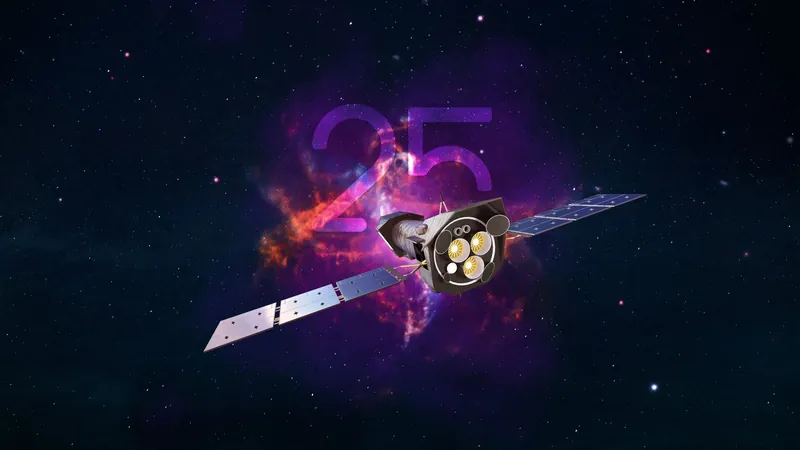
XMM-Newton: Celebrating 25 Years of Game-Changing Discoveries in X-ray Astronomy
2024-12-10
Author: Michael
On December 10, 2024, ESA's revolutionary X-ray observatory, XMM-Newton, marks a significant milestone—25 years in orbit! Since its launch aboard an Ariane-5 rocket back in 1999, XMM-Newton has transformed our understanding of the universe, peering into the mysteries of both nearby celestial bodies and distant galaxies.
As the largest X-ray telescope currently operational, XMM-Newton has provided astronomers with a treasure trove of data, offering insight into dramatic cosmic phenomena—from the intricate workings of our own Solar System to the enigmatic realms around supermassive black holes. ESA's Director of Science, Prof. Carole Mundell, reflects on the mission's successes: "XMM-Newton has rewarded us handsomely with exceptional discoveries and continues to surprise us."
Groundbreaking Discoveries Over the Last Five Years
In honor of its 25th anniversary, let's delve into five awe-inspiring discoveries made possible by XMM-Newton over the past five years.
1. Unveiling Jupiter's X-ray Auroras
One of the most remarkable breakthroughs has been the clarification of a longstanding 40-year mystery: the mechanism behind X-ray auroras at Jupiter's poles. Utilizing joint data from XMM-Newton and NASA's Juno mission, scientists have finally visualized how Jupiter's rapidly rotating magnetic field compresses and heats trapped particles, leading to the formation of vivid X-ray auroras—a stunning demonstration of the complex interplay between magnetic fields and planetary atmospheres.
2. Insights into Neutron Stars
Closer to home, groundbreaking observations of neutron stars have enhanced our understanding of these dense celestial objects. With the help of XMM-Newton and NASA's Chandra telescope, researchers have studied three young neutron stars that appear colder than expected. This discovery allows scientists to test theories about the extreme states of matter within neutron stars, possibly leading to new insights into the behavior of particles under immense pressure.
3. Mapping Supermassive Black Holes
Moving beyond our galaxy, XMM-Newton has illuminated the environments surrounding massive black holes. Recent observations of a supermassive black hole 800 million light-years away revealed intense X-ray flares resulting from gas spiraling into it. For the first time, astronomers captured echoes of these flares, enabling them to create a three-dimensional map of the area—providing clarity on how these colossal entities govern their surroundings.
4. Tracking Galaxies’ Central Black Hole Dynamics
Another astonishing study targeted a black hole located 1 billion light-years away. XMM-Newton's observations of light echoes from its corona allowed scientists to ascertain the mass and rotation of this black hole more accurately than ever before. Understanding the dynamics within this "corona" is essential, as it strongly correlates with the properties of the black hole itself.
5. Observing Intergalactic Gas Behavior
Our journey concludes 240 million light-years from Earth in the Perseus cluster, known to house incredibly hot gas. Utilizing XMM-Newton, scientists have observed compelling evidence of gas sloshing among galaxies, unveiling vital information about how galaxy clusters grow and evolve. These gas movements potentially arise from smaller galaxy groups merging, demonstrating the dynamic structure of the cosmos.
Looking Ahead: The Future of X-ray Astronomy
Reflecting on the impressive achievements of XMM-Newton, ESA XMM-Newton Mission Manager Peter Kretschmar stated, "It is extremely gratifying to see how well XMM-Newton has been doing over a quarter of a century." With plans for future missions, including ESA's upcoming NewAthena—a giant leap in X-ray observatory technology—exciting discoveries await as we continue to explore the universe's secrets.
So, here's to XMM-Newton! Happy 25th birthday to a trailblazer in X-ray astronomy, with many more thrilling revelations on the horizon!



 Brasil (PT)
Brasil (PT)
 Canada (EN)
Canada (EN)
 Chile (ES)
Chile (ES)
 Česko (CS)
Česko (CS)
 대한민국 (KO)
대한민국 (KO)
 España (ES)
España (ES)
 France (FR)
France (FR)
 Hong Kong (EN)
Hong Kong (EN)
 Italia (IT)
Italia (IT)
 日本 (JA)
日本 (JA)
 Magyarország (HU)
Magyarország (HU)
 Norge (NO)
Norge (NO)
 Polska (PL)
Polska (PL)
 Schweiz (DE)
Schweiz (DE)
 Singapore (EN)
Singapore (EN)
 Sverige (SV)
Sverige (SV)
 Suomi (FI)
Suomi (FI)
 Türkiye (TR)
Türkiye (TR)
 الإمارات العربية المتحدة (AR)
الإمارات العربية المتحدة (AR)